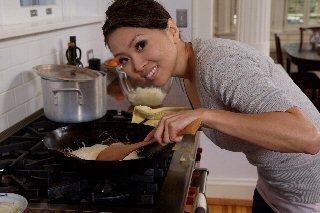Mango Sticky Rice
Sorry I've been MIA for a while. Started catering weekly dinners for my girlfriend and her friends and it took some time to organize the menu (of course you know I had to take pics of all the dishes too). But I'm back with a dessert recipe that will make you fall in love with mangoes and sticky rice if you're not already.
Next to Vietnamese, Thai food would have to be my second favorite food to cook. They really know what they're doing with the sticky rice and coconut milk. Coconut milk has a magical way of making ordinary foods taste super extraordinary. Like ice tea? Add coconut milk. Like curry? Add coconut milk. Like ice cream? Add coconut milk. Like sticky rice? Add coconut milk. And that's exactly what we've done here with this Mango Sticky Rice dessert.
Don't even think of making this without a sticky rice steamer. I've tried using a rice cooker and it turns out mushy. You have to be dead on with how much water you put in it and since sticky rice is not cheap, I'd rather do it the right way the first time. You can find steamers at most Asian stores and also Ai's Kitchen Store
Ingredients:
3 Cups Sticky Rice (much cheaper and more available at Asian stores)
2 Cans Coconut Milk (Stick to Asian brands. ChaoKoh is the best. No Goya.)
1/2 Cup Sugar
2 Ripe Mangoes
Sesame Seeds
Shredded Coconut
STEP 1: Place the rice in a large mixing bowl and fill it with water. Soak for 1 hour.
STEP 2: Fill the steamer pot with water about 2 inches high. Hold your bamboo steamer basket over the sink and pour the rice with the water into it. You will be using it as a strainer. Then place the basket on top of the pot. Just make sure the water doesn't touch the bottom of the basket or else you will be cooking instead of steaming. Cover the basket and steam for about 30 minutes. Your rice is done when it turns translucent. If you still see white on the ends of the grains, keep steaming for a few more minutes.
STEP 3: While the rice is steaming you can prep the mangoes and coconut sauce. Peel, cut and slice mangoes lengthwise. (How to cut a mango.) If you're making this for a party, you can place slices on a plate/platter and fan it out in a pretty layout.
STEP 4: Place coconut milk and sugar in a pot and heat for a couple of minutes, just enough to dissolve sugar. Set aside.
STEP 5: Combine rice with approximately 3/4 of the coconut mixture, blend with a spoon. It's hard to go wrong with this step. Even if you put too much coconut milk, the rice will absorb it once it sets. Place rice in a rectangular pan. The larger the pan, the thinner the rice will be. I like mine to be between 3/4 -1 inch thick. Let the rice cool and set. Once it's cooled, sprinkle with roasted sesame seeds.
STEP 6: To serve, just cut the rice like you would a brownie pan. Drizzle some coconut sauce on the plate, then place rice on top of it. Add mangoes either on top or to the side, then garnish with shredded coconut and coconut sauce.







